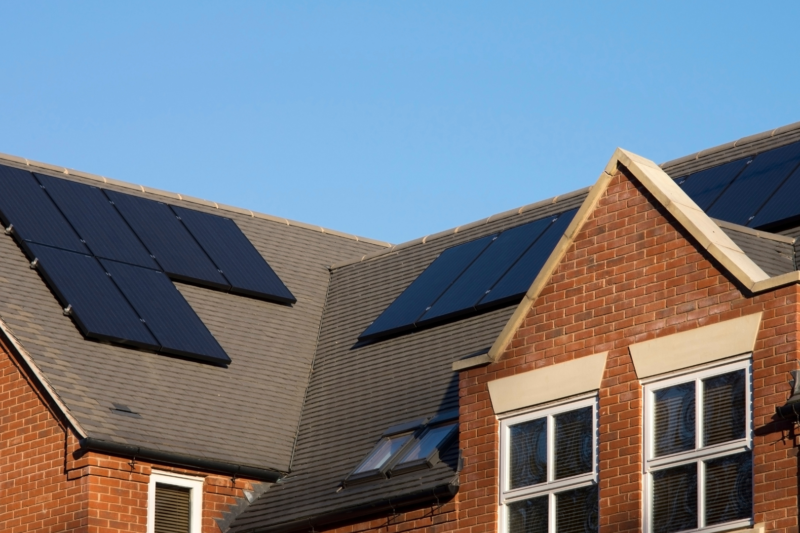A little over two years ago, the UK government found that home and business owners faced extra costs and wait times of over eight weeks when trying to install solar panels on their properties.
To make the switch to solar easier, the government made various changes to permitted development rights rules. They did so by cutting red tape in the planning system so that people could install solar panels without being ‘held up’ by costly delays.
So, do you need planning permission for solar panels, and are there exceptions to these new rules? Find out with Project Solar.
Do I need planning permission to install solar panels?
In most cases, planning permission isn’t required for installing solar panels on UK homes. Many of these installations are classified as ‘permitted development’, meaning homeowners don’t need to apply for formal permission from their local authority.
Planning permissions account for installations on detached, semi-detached, and terraced houses and the roofs of outbuildings. Your MCS-certified installer will also need to determine whether the roof can support the weight of the solar panel system.
Despite these rather generous regulations, they still come with specific conditions (and even some exceptions). Planning permission is required in the following circumstances:
Listed buildings
For listed buildings, planning rules tend to be stricter. You’ll likely need listed building consent before making any changes, including solar panel installation. But why?
Listed properties are protected for their historic importance, and any alterations must preserve their character. Always check with your local planning authority before purchasing and arranging installation! For detailed information, consult Historic England.
Flats
If you live in a flat, planning permission depends on the ownership structure and whether the building falls under permitted development rights.
Since the panels would typically be installed on shared roofs, permission from both the building management and the local council may be necessary. You can check the UK Government’s Planning Portal for more specific information.
Properties in conservation areas
Conservation areas are spaces that are protected to preserve their architectural or historic interest. While solar panels can still be installed in these areas, they must be positioned in a way that doesn’t alter the visual integrity of the property (or surrounding areas).
For example, the Planning Portal recommends placing panels on the rear or side roof slopes, where they’re less visible from the street.
Do I need planning permission for solar panels that are not subject to these conditions?
So, you don’t live in a flat with shared ownership, a listed building or a conversation area. If you’re still wondering ‘do I need planning permission for solar panels?’, here’s a breakdown of the conditions you must meet to bypass the ‘red tape’:
1. Solar panels mounted on a house or a block of flats (or a building on the grounds of a house or flats)
- Projection: Panels should not extend more than 200mm beyond the plane of the roof slope or wall surface
- Height: On pitched roofs, panels must not be installed above the highest part of the roof (excluding chimneys). For flat roofs, the highest part of the solar equipment should not be more than 600mm above the highest part of the roof (excluding chimneys).
- Designated areas: If the property is in a conservation area or World Heritage Site, panels cannot be installed on a wall that fronts a road.
- Listed buildings: Panels cannot be installed on buildings within the grounds of a listed building or on sites designated as scheduled monuments.
2. Stand-alone solar panels on domestic premises (panels not on a building)
- Size and height: The installation must not exceed 4 metres in height. The panel’s size should not surpass 9 square metres, with no dimension exceeding 3 metres.
- Proximity to boundaries: The installation should be at least 5 metres away from the property boundary.
3. Wall-mounted solar panels
Not all properties have the required roof space for solar panels, so in some cases, they can be mounted on walls. For these installations, the following considerations must be made:
- Structural support: An MCS-qualified installer needs to assess whether the building’s walls can support the additional weight of the solar panels.
- Overhanging/overshadowing: Proper placement is essential to prevent overhanging, which could pose safety risks (or encroach on other properties). Potential overshadowing effects on adjacent buildings must also be considered, as this could impact access to natural light.
Common mistakes to avoid when applying for planning permission for solar panels
If you or an installer have determined that planning permission will be necessary, it’s time to start an application. You can make the process smoother by avoiding these common mistakes:
Incomplete application
Submitting an application that lacks the necessary details can lead to delays or even rejections.
Please double-check that your application includes a comprehensive site plan indicating the proposed location of the solar panels. Also, be sure to provide information on the type, size, and appearance of the panels.
Neglecting talks with neighbours
Your neighbours should always be kept in the loop, particularly for site alterations.
Overlooking these discussions could result in potential objections during the planning review! That’s why you should give any neighbouring property owners a quick heads-up. Make sure the installation doesn’t block sunlight to adjacent properties.
Also, discuss how the panels may alter the property’s appearance.
Join the solar takeover!
Now that the government has made panel installations easier, why not join the solar takeover? There’s never been a better time to supplement your home’s electricity supply with energy generated directly from the sun. Contact us today for more information.

